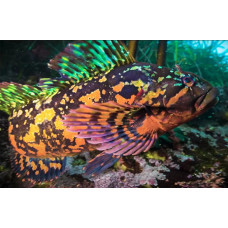Latin name
Hexagrammos lagocephalus
Other names
Fringed greenling
Identification
There are two forms: Asian and American. In the Asian form the supraorbital lobes are short and massive, while in the American form they are very long. In both forms, the fourth lateral line is long and extends beyond the beginning of the base of the anal fin. The fifth forks at the center of the pelvic fins. The head is largely bare. The teeth on the front of the upper and lower jaws are enlarged, but largely hidden by the thick leathery edge of the jaws. The teeth on the coulter are present, but they are small and located only on the anterior edge of the coulter head. There are no teeth on the palatines; instead, there is a fringe similar to the fringe on the jaws. In younger specimens, the head and body are considerably compressed from the sides.
Features of fish fins
Caudal fin rounded. Dorsal fin high, with deep notch. Dorsal rays (total): 20-21; Dorsal soft rays (total): 23-24; Anal rays: 0; Anal soft rays: 21-22.
Fish colouring
Sexual dimorphism is strongly expressed in coloration. In males, the coloration is dark cherry red, the lower part of the head is orange, the belly is dark gray-blue. The lower parts of the pectoral, ventral and anal fins are black. The edges of the pectoral, dorsal, and caudal fins are red or bright pink. There are blue spots on the body and fins. Eyes are red. Juveniles are greenish brown.
Distribution
Eastern Pacific: Bering Sea and Kuril Islands to Point Conception, Central California, USA. Data come in from the northern part of the Sea of Japan, Hokkaido and the Sea of Okhotsk. The Asian form occurs off Hokkaido, Kamchatka, Kuril, Commander and Aleutian Islands, and the American form from Alaska to California.
Habitat
Marine benthic species. Depth range from 0 to 596 m, usually 10-15 m. Prefers temperate climates. Preferred habitat is rocky shores. Occasionally found at low tide and on sandy areas.
Size
Has a massive body up to 60 cm long. Maximum declared weight: 830 g.
Behavior
This species is usually solitary. It is not aggressive, which makes it easy to keep in public aquariums. However, it is often elusive to divers and spearfishers, as it prefers to live among rocks and strong waves.
Food and feeding habits
A predator that feeds on everything from invertebrates such as crabs and isopods to fish eggs and algae. When young, the fish feeds on zooplankton.
Reproduction
Spawn in fall or winter. Eggs are brown, blue or purple.
Fishing
A popular commercial fish. Most live in areas inaccessible to commercial vessels. They are usually caught by recreational anglers off exposed rocky shores.
Relationship with a person
The economic value is low. The meat is edible but not very tasty.
| Classification | |
| Phylum | Chordata |
| Class | Actinopterygii |
| Squad | Scorpaeniformes |
| Family | Hexagrammidae |
| Genus | Hexagrammos |
| Species | H. lagocephalus |
| Features | |
| Conservation status | Least Concern |
| Habitat | Bottom |
| Life span, years | No information |
| Maximum body weight, kg | 0,83 |
| Maximum length, cm | 60 |
| Sailing speed, m/s | No information |
| Threat to people | Edible |
| Way of eating | Predator |
Rock greenling
Tags: rock greenling



